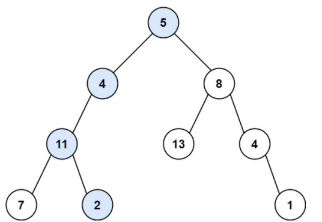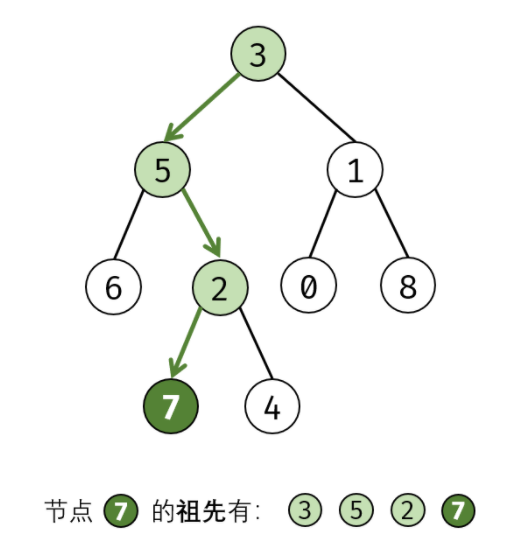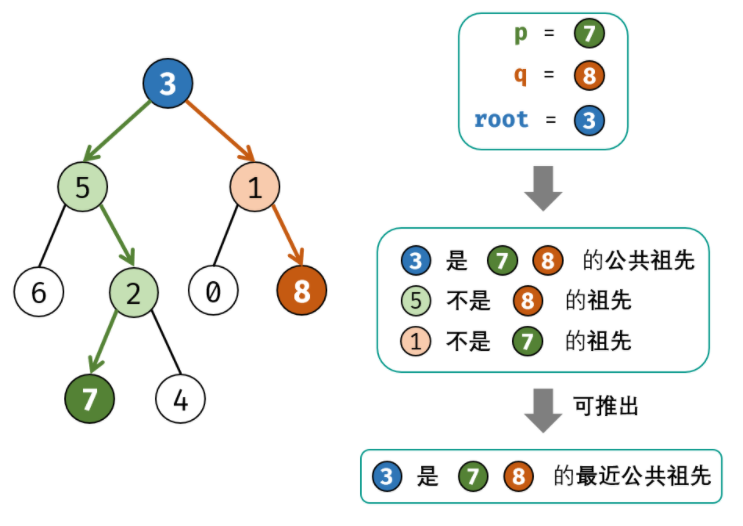二叉树常见题记录
二叉树的最大深度
给定一个二叉树,找出其最大深度。
二叉树的深度为根节点到最远叶子节点的最长路径上的节点数。
说明: 叶子节点是指没有子节点的节点。
示例:
给定二叉树 [3,9,20,null,null,15,7]
3
/ \
9 20
/ \
15 7
返回它的最大深度 3
这题就像斐波那契数列那样往一个方向延展的递归
public static void main(String[] args) {
TreeNode root = new TreeNode(1,
new TreeNode(2, new TreeNode(4), new TreeNode(5)), new TreeNode(3));
System.out.println(maxDepth(root));
}
public static int maxDepth(TreeNode root) {
if (root == null) return 0;
return Math.max(maxDepth(root.left) + 1, maxDepth(root.right) + 1);
}
对称二叉树
给定一个二叉树,检查它是否是镜像对称的。
例如,二叉树 [1,2,2,3,4,4,3] 是对称的。
1
/ \
2 2
/ \ / \
3 4 4 3
但是下面这个 [1,2,2,null,3,null,3] 则不是镜像对称的:
1
/ \
2 2
\ \
3 3
public static void main(String[] args) {
TreeNode root = new TreeNode(1,
new TreeNode(2, new TreeNode(4), new TreeNode(5)), new TreeNode(3));
System.out.println(isSymmetric(root));
}
public static boolean isSymmetric(TreeNode root) {
return isMirror(root.left, root.right);
}
public static boolean isMirror(TreeNode t1, TreeNode t2) {
if (t1 == null && t2 == null) return true;
// 既然有且至少一个不为 null,说明只要一个为 null 那一定是不同的(要么就都不为 null)
if (t1 == null || t2 == null) return false;
return (t1.val == t2.val)
&& isMirror(t1.left, t2.right)
&& isMirror(t1.right, t2.left);
}
路径总和
参考资料 蓝士钦的回答
给你二叉树的根节点 root 和一个表示目标和的整数 targetSum ,判断该树中是否存在 根节点到叶子节点 的路径,这条路径上所有节点值相加等于目标和 targetSum 。
叶子节点 是指没有子节点的节点。

输入:root = [5,4,8,11,null,13,4,7,2,null,null,null,1], targetSum = 22
输出:true
- 树中节点的数目在范围 [0, 5000] 内
- -1000 <= Node.val <= 1000
- -1000 <= targetSum <= 1000
思路:
递归法,每递归到一个节点,就拿 target 减去当前节点值,如果最后一个叶子节点等于 target 剩下的值,则存在路径总和等于 target。
反之如果递归到叶子节点后,剩余的 target 值不等于叶子节点,说明不存在路径总和等于 target。
public static void main(String[] args) {
TreeNode root = new TreeNode(1,
new TreeNode(2, new TreeNode(4), new TreeNode(5)),
new TreeNode(3));
System.out.println(hasPathSum(root, 8));
}
public static boolean hasPathSum(TreeNode root, int targetSum) {
if (root == null) return false;
if (root.left == null && root.right == null) {
return root.val == targetSum;
}
// 只要一个返回 true 就存在
return hasPathSum(root.left, targetSum - root.val) || hasPathSum(root.right, targetSum - root.val);
}
二叉树的最近公共祖先
给定一个二叉树, 找到该树中两个指定节点的最近公共祖先。
示例 1:

输入:root = [3,5,1,6,2,0,8,null,null,7,4], p = 5, q = 1
输出:3
解释:节点 5 和节点 1 的最近公共祖先是节点 3 。
示例 2:
输入:root = [3,5,1,6,2,0,8,null,null,7,4], p = 5, q = 4
输出:5
解释:节点 5 和节点 4 的最近公共祖先是节点 5 。因为根据定义最近公共祖先节点可以为节点本身。
示例 3:
输入:root = [1,2], p = 1, q = 2
输出:1
提示:
- 树中节点数目在范围 [2, 105] 内。
-109 <= Node.val <= 109- 所有 Node.val 互不相同 。
p != q- p 和 q 均存在于给定的二叉树中。
题解 递归解析:
参考资料 236. 二叉树的最近公共祖先(后序遍历 DFS ,清晰图解)
祖先的定义: 若节点 p 在节点 root 的左(右)子树中,或 p = root,则称 root 是 p 的祖先。

最近公共祖先的定义: 设节点 root 为节点 p, q 的某公共祖先,若其左子节点 root.left 和右子节点 root.right 都不是 p, q 的公共祖先,则称 root 是 “最近的公共祖先” 。
根据以上定义,若 root 是 p, q 的 最近公共祖先 ,则只可能为以下情况之一:
- p 和 q 在 root 的子树中,且分列 root 的 异侧(即分别在左、右子树中);
- p = root,且 q 在 root 的左或右子树中;
- q = root,且 p 在 root 的左或右子树中;

考虑通过递归对二叉树进行后序遍历,当遇到节点 p 或 q 时返回。从底至顶回溯,当节点 p, q 在节点 root 的异侧时,节点 root 即为最近公共祖先,则向上返回 root。
递归解析:
终止条件:
- 当越过叶节点,则直接返回 null;
- 当 root 等于 p, q,则直接返回 root;
递推工作:
- 开启递归左子节点,返回值记为 left
- 开启递归右子节点,返回值记为 right
返回值:
根据 left 和 right,可展开为四种情况;
1、当 left 和 right 同时为空:说明 root 的左 / 右子树中都不包含 p,q,返回 null;
2、当 left 和 right 同时不为空:说明 p,q 分列在 root 的异侧(分别在 左 / 右子树),因此 root 为最近公共祖先,返回 root;
3、当 left 为空,right 不为空:p,q 都不在 root 的左子树中,直接返回 right 。具体可分为两种情况:
p,q其中一个在 root 的右子树中,此时 right 指向 p(假设为 p);p,q两节点都在 root 的 右子树 中,此时的 right 指向最近公共祖先节点;
4、当 right 为空,left 不为空,同上

代码示例:
class Solution {
public TreeNode lowestCommonAncestor(TreeNode root, TreeNode p, TreeNode q) {
if(root == null || root == p || root == q) return root;
TreeNode left = lowestCommonAncestor(root.left, p, q);
TreeNode right = lowestCommonAncestor(root.right, p, q);
if(left == null && right == null) return null; // 1.
if(left == null) return right; // 3.
if(right == null) return left; // 4.
return root; // 2. if(left != null and right != null)
}
}
判断是否是平衡二叉树
首先平衡二叉树的定义:它是一棵空树或它的左右两个子树的高度差的绝对值不超过1,并且左右两个子树都是一棵平衡二叉树。
最直接的做法,遍历每个结点,借助一个获取树深度的递归函数,根据该结点的左右子树高度差判断是否平衡,然后递归地对左右子树进行判断。
public classSolution {
public boolean IsBalanced_Solution(TreeNode root) {
if(root == null) {
return true;
}
return Math.abs(maxDepth(root.left) - maxDepth(root.right)) <= 1 &&
IsBalanced_Solution(root.left) &&
IsBalanced_Solution(root.right);
}
private int maxDepth(TreeNode root) {
if(root == null) {
return 0;
}
return 1 + Math.max(maxDepth(root.left), maxDepth(root.right));
}
}
这种做法有很明显的问题,在判断上层结点的时候,会多次重复遍历下层结点,增加了不必要的开销。
如果改为从下往上遍历,如果子树是平衡二叉树,则返回子树的高度;如果发现子树不是平衡二叉树,则直接停止遍历,这样至多只对每个结点访问一次。
public class Solution {
public boolean IsBalanced_Solution(TreeNode root) {
return getDepth(root) != -1;
}
private int getDepth(TreeNode root) {
if (root == null) return 0;
int left = getDepth(root.left);
if (left == -1) return -1;
int right = getDepth(root.right);
if (right == -1) return -1;
return Math.abs(left - right) > 1 ? -1 : 1 + Math.max(left, right);
}
}